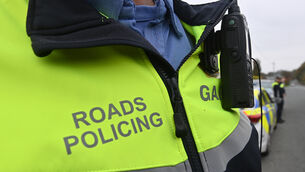Taxi driver admits part in transport of human cargo
He worked for the Albanian Kosovan gang accused of the manslaughter of eight people found dead in a container of furniture at
Drinagh business park in Wexford in December 2001. Mohamed Kebdani, 31, who lives in Anderlecht, Brussels denied he took any of the 13 people eight men, two women, a 10-year old girl and two boys aged four and nine to the container on December 4, 2001.
"I would have remembered if there were children, but I did not bring any children," he told the court of three judges in Bruges.
He is charged with seven others of the manslaughter of six Turks, an Algerian and a Kosovan. They are also charged with being members of a criminal gang, of trafficking people and of involuntary assault.
Those accused also include two other taxi drivers, 37-year-old Moroccan Abdeslam Tribak, who lives in Oudergem, Belgium, and Enver Berisha, aged 48, a Kosovan, who lives in Wemmel, Belgium. The others charged are Albanian Kosovans Flamour Domi, aged 45, and his son 20-year-old Donald, who live in Brussels, and the Belgian lorry driver, Johan Schrowen, aged 50.
The lorry driver picked up the truck in Cologne in Germany where the consignment of furniture came by rail from Milan in Italy. He drove it to a parking lot outside Brussels where he spent the night of December 3-4 sleeping in his cab.
He told detectives he did not know the illegal immigrants had broken into the container. But an expert in sound and vibration told the court that any normal human being would have been wakened by the noise and the vibrations. He left Brussels at 9am and arrived in the port of Zeebrugge at 11.45am, but did not register the container for another two hours.
These crucial two hours are missing and not accounted for, the court was told. The driver claimed he had been searching for the port. Det Supt Pat Brehony said the 13 people were put into the container outside Brussels by two people at 4am on December 4.
In Zeebrugge, the container was loaded onto the ship, the Dutch Navigator, with 53 other containers. It set sail at 8.35pm on December 4. It arrived into Belleview port in Waterford over two days later at 11pm on December 6. They were in the container for more than 100 hours. They were told they were travelling to Dover and would be there within three hours. They were given 18 one-and-a-half litre bottles of water and some cheese for the journey. However, they did not realise the container was going directly to the south of Ireland, a trip that would normally take 42 hours.
During the journey, the ship was hit by force 10 gales, which added another 10 hours to the journey.
The container was delayed at the Waterford port another day because the wrong one was driven away first.
The Irish driver who eventually collected the container with the people inside heard noise when he pulled into the business park in Drinagh, Co Wexford, on December 8. The seal on the door fell apart when it was touched by a supervisor who called the gardaí. "The full horror unfolded when we opened the truck," said Det Supt Brehony.
The five survivors were on top of containers lying as close as they could get to the four air vents in the roof.
The gardaí found about 164 phone numbers concealed on pieces of paper inside the lining of the clothing of the victims, some of which they traced to two of the accused, Ozgur Doganbaloglu in Britain and to Bekim Zogaj in Brussels. They worked closely with the police in Italy, Germany, Belgium and Turkey and eventually, with the help of the survivors, built up a picture of what had happened.
The survivors painted an horrific picture of their journey. Almost as soon as the container was loaded on to the ship, they were in complete darkness. The hold of the ship was closed because of the storm and because they were positioned close to the engine, the air heated up unbearably.
While the four vents in the roof were open, they were not designed to provide sufficient air. "One survivor said that within an hour of getting in they began to panic and feel there was not enough air." A marine engineer and ventilation expert employed by the gardaí said that anybody close to the floor of the container would die within 40 minutes, while those sitting higher up would last up to six hours lying down and 18 hours sitting up. Those at the top close to the ceiling would survive for 24 hours lying down and up to 50 hours seated.
The expert told the gardaí that most of them would have died within 23 to 33 hours of being put into the container. In fact those that survived were there for more than 100 hours. State Pathologist Dr John Harbison found they suffocated. The survivors were Kalendeigil Kadriye, aged 33, now in London, who lost her husband and two sons, aged 16 and 12; Eyup Isik, who now lives in Wexford, as does Shefki Ajeti and Abdul Majid Habar, and Karadede Guler, who lives in Dublin. He lost his wife and two children aged 9 and 4. The hearing continues today in Bruges and may go into a third day. The three judges may reserve their judgment for a week or two. Civil cases are being taken by the families of some of the victims and by the Centre against Discrimination and Racism in Brussels.











